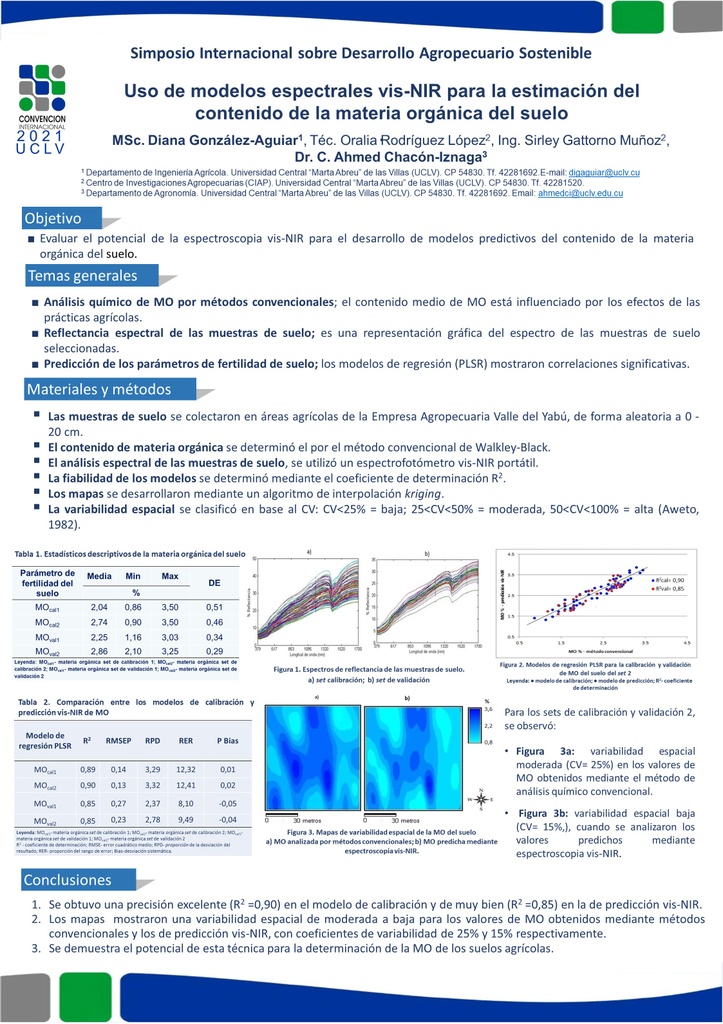Executive Secretary

X Conferencia Científica Internacional sobre Desarrollo Agropecuario y SostenibilidadAGROCENTRO 2023
Agrocentro 2021

Resumen
La materia orgánica (MO) es un parámetro importante de la fertilidad del suelo, que tiene efectos beneficiosos sobre otras propiedades y en el crecimiento y producción de raíces tuberosas como el boniato (Ipomoea batatas (L.) Lam). La técnica de espectroscopia en el visible e infrarrojo cercano (vis-NIR) combinada con técnicas estadísticas multivariables, como la de regresión por mínimos cuadrados parciales (PLSR), han proporcionado nuevas posibilidades para la predicción de la MO del suelo. El objetivo de la investigación fue evaluar el potencial de la espectroscopia vis-NIR para el desarrollo de modelos predictivos del contenido de MO del suelo. Se colectaron 256 muestras de suelo de diferentes áreas agrícolas de la provincia de Villa Clara, y se dividieron en cuatro grupos a razón de 2:1, para la calibración y validación de los modelos respectivamente. Se utilizó un espectrofotómetro vis-NIR portátil en el rango de longitud de onda de 399 a 1697 nm, para la obtención de los espectros de suelo. Se realizó el pre-procesamiento con el fin de remover los datos irrelevantes que interfieren en la información química. Los modelos PLSR fueron evaluados en base a los siguientes estadísticos; coeficiente de determinación (R2), errores cuadráticos medios de la validación cruzada (RMSECV) y predicción (RMSEP). Se aplicó la técnica de validación cruzada (Persianas venecianas), para optimizar la complejidad del modelo y obtener una predicción fiable de este parámetro de fertilidad del suelo. Se obtuvieron correlaciones significativas entre los espectros de suelo y el contenido de MO con valores de 0.85≤R2≤0.90.
Abstract
Organic matter (OM) is an important parameter of soil fertility, which has beneficial effects on other properties and on the growth and production of tuberous roots such as sweet potato (Ipomoea batatas (L.) Lam). The visible and near infrared spectroscopy (vis-NIR) technique combined with multivariate statistical techniques, such as partial least squares regression (PLSR), have provided new possibilities for the prediction of soil OM. The objective of the research was to evaluate the potential of vis-NIR spectroscopy for the development of predictive models of the OM content of the soil. 256 soil samples were collected from different agricultural areas of the Villa Clara province, and they were divided into four groups at a ratio of 2: 1, for the calibration and validation of the models respectively. A portable vis-NIR spectrophotometer in the wavelength range of 399 to 1697 nm was used to obtain the soil spectra. The pre-processing was carried out in order to remove irrelevant data that interferes with the chemical information. The PLSR models were evaluated based on the following statistics; coefficient of determination (R2), mean square errors of cross validation (RMSECV) and prediction (RMSEP). The cross-validation technique (Venetian blinds) was applied to optimize the complexity of the model and obtain a reliable prediction of this parameter of soil fertility. Significant correlations were obtained between the soil spectra and the OM content with values of 0.85≤R2≤0.90.
Sobre el ponente

MsC. Diana González Aguiar

Master en Agricultura Sostenible. Presidenta de las Brigadas Técnicas Juveniles (BTJ). Profesora del Departamento de Ingeniería Agrícola, FCA, UCLV.
Discussion

